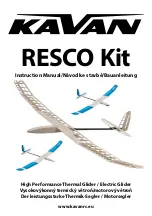
Revision: 4
Date:
09/08/20
RV-12iS Flight Training Supplement
10-1
SECTION X
CRUISE
INDEX
CRUISE
10-1
ALTITUDE, SPEED & EFFICIENCY
10-1
CRUISE FOR MAX SPEED
10-1
CRUISE FOR MAX RANGE
10-1
CRUISE FOR MAX ENDURANCE
10-1
CRUISE
See POH Checklist
ALTITUDE, SPEED & EFFICIENCY
Cruising at high altitude provides various benefits, as the aircraft is more efficient when flown high, allows more time for
decision making in the event of in-flight emergencies (such as engine failure), and there is generally less turbulence at
high altitude than when flying closer to the ground. The only time to vary from this is when unfavorable winds occur or if
cloud bases preclude flying higher.
When flying into a headwind, it is often best to use higher power settings (maximum cruise power) as it will minimize the
impact of the headwind in terms of slowing progress over the ground.
When flying with a tailwind, it is typically most efficient to use lower power settings (economy cruise power) as this
will maximize the impact the tailwind has in aiding progress over the ground.
CRUISE FOR MAX SPEED
If the objective of the flight is to get to your destination as quickly as the aircraft is capable of getting you there, the
pilot should fly at as low an altitude as can be done safely, and open the throttle as much as possible without
exceeding engine RPM limitations. If the ECO throttle stop is set correctly with the 912 iS engine, the aircraft will be
just inside the upper limits of the ECO mode operating range at or just below 5500 rpm.
For a Rotax 912ULS equipped aircraft this is a very inefficient way to travel and, if the destination is more than 2.5
hours away, may end-up taking more time due to the need to stop and re-fuel. Cruising at max speed makes sense
when flying into severe headwinds because it minimizes the detrimental effect of the headwind.
CRUISE FOR MAX RANGE
If the objective of the flight is to get to your destination while using as little fuel as necessary, the pilot should fly at
as high an altitude as practical and, for a Rotax 912ULS equipped aircraft, select a throttle setting so as to yield 87
kts indicated airspeed. The optimum situation is to fly high enough so that the aircraft is flying at its most efficient
indicated airspeed when the throttle is as open as possible. The altitude required for this to occur is above 12,500
ft, which would require use of supplemental oxygen. Cruising at max-range indicated airspeed should be selected
for all flights unless wind conditions or other considerations make cruising at another speed more desirable.
When flying into a headwind, the indicated airspeed to achieve max range is 4 kt greater for every 10 kt of
headwind.
When flying with a tailwind, the indicated airspeed to achieve max range is 3 kt lower for every 10 kt of tailwind.
CRUISE FOR MAX ENDURANCE
If the objective of the flight is to remain airborne for a longer amount of time while using as little fuel as is
necessary, the pilot should select a throttle setting so as to yield 65 kts indicated airspeed regardless of altitude.
Cruising at max-endurance indicated airspeed makes sense if the aircraft is being used as an observation platform
or for some other mission where time spent aloft is of greater concern than the number of miles covered.
Summary of Contents for RV 12iS
Page 1: ...Revision 4 Date 09 08 20 RV 12iS Flight Training Supplement i FLIGHT TRAINING SUPPLEMENT...
Page 14: ...Revision 4 Date 09 08 20 RV 12iS Flight Training Supplement 4 2...
Page 15: ...Revision 4 Date 09 08 20 RV 12iS Flight Training Supplement 4 3...
Page 50: ...Revision 4 Date 09 08 20 RV 12iS Flight Training Supplement 6 2 ELECTRICAL SWITCHES KNOBS...
Page 56: ...Revision 4 Date 09 08 20 RV 12iS Flight Training Supplement 6 8...
Page 89: ...Revision 4 Date 09 08 20 RV 12iS Flight Training Supplement REAR COVER...














































